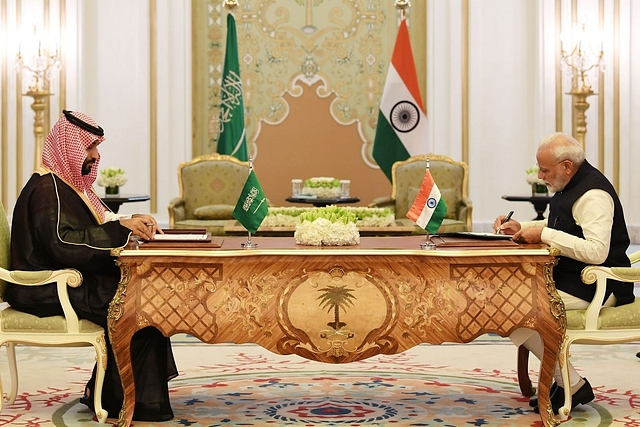
Modi’s Saudi Embrace Is Economically Beneficial, But Beware Of Letting Camel Too Far Into The Tent
India should indeed welcome Saudi and UAE investments in infrastructure and in countering terrorism, but it should remain wary about Saudi interest in Indian Islam.
As long as India is aware of this reality, the relationship will benefit both parties.
Ever since Narendra Modi became Prime Minister in 2014, he has invested huge diplomatic capital in building a strong relationship with the Gulf nations, especially Saudi Arabia and the United Arab Emirates (UAE).
This growing relationship is not only because India imports over 80 per cent of its oil, most of it from the Gulf, but also because there has been a growing convergence of interests. India needs to secure global investments for its infrastructure push, and also to improve security cooperation against jihadi elements, areas in which the Saudi oil wealth can help. India, on the other hand, is the logical place for the Saudis to invest for the long term in preparation for a future when oil may not gush profits.
During his recent visit to Saudi Arabia, Modi not only spoke of all these issues, but also sought Saudi investment in expanding India’s oil refining, pipeline and gas grid infrastructure. There are reports that the Saudis may bid for Bharat Petroleum when it is put up for auction by the government, and Saudi Aramco was said to be negotiating a stake purchase in the oil and refining assets of Reliance Industries. The Saudis will invest $60 billion in a large west coast refinery.
In recent years, both the Saudis and the UAE have helped India by extraditing terrorists and alleged scamsters hiding in their domains. The UAE has allowed India to renovate a temple in the Gulf – a rare event in the Arabian peninsula when Islam frowns on anything to do with religions that use iconography or idols. The Indian embrace and the existence of a large Indian workforce in the Gulf has played quiet catalyst in the region’s liberalising tendencies.
From the Saudi side, there are needs that go beyond just finding large markets for their crude oil and scope for value-adding opportunities. The Saudis probably want to balance their over-dependence on Pakistan given the latter’s growing ties with Turkey and Iran – rival claimants to global Islamic leadership. There are some indications that Saudi Arabia-Pakistan ties are fraying at the edges, even though the core alliance remains.
Pakistan as a den of terrorists may be useful for the Chinese, who have the power to control them through authoritarian means, but the Saudis are vulnerable to Islamic radicalism emanating from Pakistan’s Taliban, Lashkar-e-Taiba and Jaish-e-Mohammed links. It is worth mentioning that Osama bin Laden posed a threat not only to the west, but the Saudi royals themselves.
There is also a global nudge from America that is driving India-Saudi-UAE ties. Under Donald Trump, the US security establishment wants India to distance itself from Iran, and one way of compensating for this is through a stronger alliance with Saudi Arabia and the UAE. In fact, this trend goes beyond India. The Saudis have built back-channel alliances with Islam’s alleged arch-enemy, Israel, again driven by Iranian ambitions about leadership of the Islamic world. The alleged Iranian attack on Saudi oil installations is an indicator of where geopolitics is heading in this region.
At another level, the Saudis under Crown Prince Mohammed bin Salman, have been trying to undo decades of extreme Islamic conservatism by liberalising attitudes towards women, and reducing the power of the old conservatives. But this initiative, which involved a lot of violence and authoritarian moves, is still a work in progress. The end-game in liberalising this conservative kingdom is far from clear.
If all this suggests a natural partnership between India and the Gulf, especially Saudi Arabia and the UAE, there are also huge accompanying risks. Optically the relationship may help Indian Muslims to see coexistence with Hindus as natural in this country, but there is no gainsaying the fact that Saudi Wahhabism has been growing its footprint in India, and many Muslims are getting radicalised by the building of Saudi-funded mosques. The fact that even a literate state like Kerala has generated recruits for Islamic State should serve as a warning.
The Saudis also fund mosques in our two neighbouring states, Pakistan and Bangladesh, and both these states have been busy ethnically cleansing themselves of non-Muslims, including Muslims deemed non-Muslims by the Wahhabists due to the adoption of non-Sunni or syncretic practices. The list of enemies now includes not only 'idol worshippers' and 'kafirs' like Hindus, but also the Shias, Ahmaddiyas and Bahais. It is no coincidence that Wahhabism has led to attacks on Shia mosques not only in Pakistan, but also Afghanistan.
India’s new relationship with Saudi Arabia and UAE, while certainly beneficial to both parties economically, is also fraught with risk. It will last only as long as the Gulf interest stays focused on economic cooperation, and not Dawa – the spread of Islamic ideas in India.
India should indeed welcome Saudi and UAE investments in infrastructure and in countering terrorism, but it should remain wary about Saudi interest in Indian Islam. India has already paid a high price for the spread of Wahhabism in the country, and it cannot afford to allow this ideology to spread.
As long as India is aware of this reality, the relationship will benefit both parties. Having allowed the camel into the tent, it is India’s duty to ensure that it is not pushed out of it by Saudi interest in socio-religious activities. We need to be eternally vigilant.